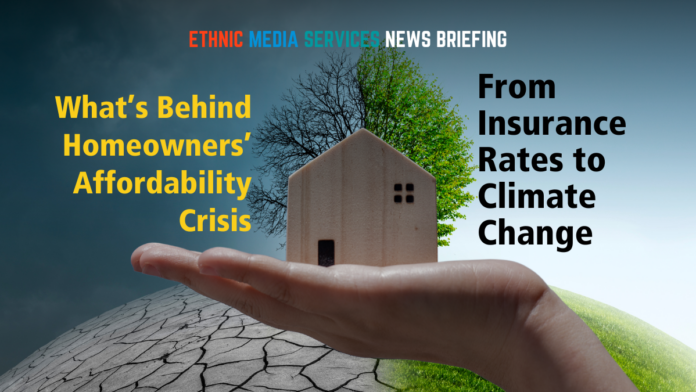Vidya Sethuraman
India Post News Service
As climate change has intensified in recent years, insurance companies in areas most affected by extreme disasters such as floods, hurricanes, and wildfires have increased premiums for homeowner’s insurance, or even terminated business or withdrawn completely.
In the past, obtaining or maintaining homeowners’ insurance was relatively easy. However, as climate change intensifies the frequency and severity of extreme weather, insurers particularly in regions most affected by floods and fires are raising their premiums or withdrawing entirely, affecting the affordability and availability of home and fire insurance.
The severe and urgent crisis in the homeowner’s insurance market is not something that only homeowners need to care about: the spillover effect is likely to be felt in housing and mortgage markets and local economies. It is also a sign of the alarming increase in the number and severity of weather and climate disasters in the United States, which broke records in frequency and cost last year.
EMS briefing on June 7 examined this issue, explained how it affects people’s lives, and discussed possible solutions in which the insurance industry, government, and ordinary people play important roles.
Vickie Kilgore, Assistant Vice President, The Insurance Research Council pointed out that between 2001 and 2021, the proportion of homeowners insurance expenditures in total income increased significantly across the United States, from 1.27% to 1.99%. The affordability of homeowners insurance varies widely between states, with climate disasters bearing the brunt.
Jordan Haedtler, Climate Financial Strategist with the Sunrise Project and Climate Cabinet said that the Consumer Federation of America recently estimated that 6.1 million homeowners in the United States are uninsured, and their total property value reaches $1.6 trillion. Without or underinsured, homeowners, businesses and renters will be unable to afford to rebuild in the event of a climate disaster and may forgo their mortgages. This means the costs of a climate disaster could ripple into the banking sector and spread throughout the economy.
Carol Kousky, Associate Vice President for Economics and Policy at the Environmental Defense Fund said that to stabilize the insurance market, innovations in legislation, regulation and the private market are all important, such as federal testing of flood insurance discounts and state regulators setting basic insurance coverage, as well as reforming the claims process to make it easier for homeowners to receive full and fair compensation.
In addition, innovative insurance models, such as micro-insurance or community insurance, can also respond to changing risks. On the other hand, building a home that can withstand strong winds and using fire-resistant materials can reduce losses and insurance premiums. This requires the collaboration of individuals, communities and governments to work together to reduce disaster risks caused by climate change and ensure the safety and sustainable development of communities.
Ricardo Lara, California Insurance Commissioner said that California is implementing the largest reform in its history and developing more forward-looking strategies to deal with climate change and the insurance crisis. Driven by his team, some insurance companies have reopened insurance business locally, introduced new climate insurance methods, and lobbied Congress to implement better forest and watershed management at the federal level.
The housing industry leaders said in the letter to Congress that people with affordable housing are being hit the hardest, with nearly one in three policies increasing by at least 25 percent in the most recent coverage renewal period. States with the highest percentages of homeowners without insurance are Mississippi (13.3 percent), New Mexico (12.9 percent), West Virginia (12.3 percent) and Louisiana (12 percent). Some ways to reduce home insurance costs include bundling home and auto insurance; calling around for competitive quotes; and investing in weatherproofing.
Also Read: 8,500 homeowners to get automatic refund







